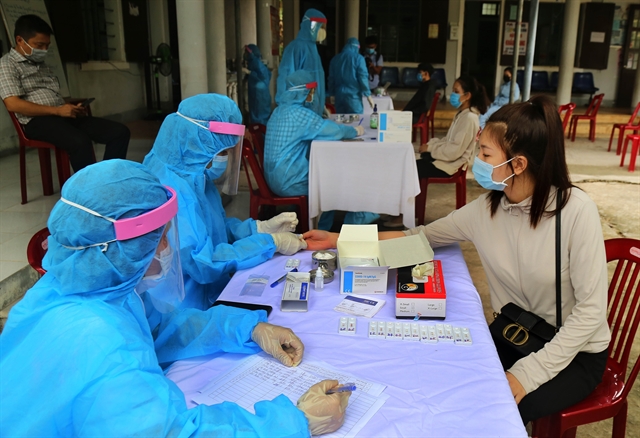Viet Nam rules out Hydroxychloroquine, uses convalescent plasma in Covid-19 treatment
Viet Nam has completely halted the use of Hydroxychloroquine, the controversial antimalaria drug touted by US President Donald Trump, in its treatment of Covid-19 patients and instead opted for plasma from recovered cases.
 |
| Health workers in Dong Ha City of Quang Tri Province test those returning from the coronavirus hotspot Da Nang on August 3. |
The information was announced by Nguyen Van Kinh, former Director of the National Hospital for Tropical Diseases and chairman of Vietnamese Society of Infectious Disease, as he discussed the latest revision of the health ministry’s Covid-19 diagnosis and treatment guidelines (the fourth comprehensive update since the coronavirus cases were first recorded in Viet Nam in late January).
The health ministry noted that while there had not been a definitive drug to treat Covid-19, a variety of antiviral drugs – including the domestically available lopinavir, ritonavir and interferon – might deliver some results as many patients were cleared of the virus within a week.
The US-made and not readily accessible remdesivir, along with Favipiravir, commonly used in Russia, were also noted as "promising" by the guidelines.
Hydroxychloroquine and Chloroquine are no longer used as their effectiveness in dealing with the disease were not ascertained, but the antibody-rich plasma from recovered Covid-19 patients is now considered a solid substitute for antiviral drugs.
In the latest guidelines, Kinh said that the health ministry had clarified SARS-CoV-2, the virus that causes the disease, is not just attacking the respiratory system but also causes problems in all internal organs.
Doctors treating Covid-19 cases should also pay attention to risks of cytokine storm, a syndrome in which the body’s own immune system goes into overdrive in response to the infection, mistakenly destroying other cells of the body in the process, leading to organ failures and other severe damage.
One of Viet Nam’s most critically-ill cases, the otherwise healthy 43-year-old Scottish pilot, spent two months on life support due to this syndrome.
Patients will be categorised into five levels for treatment, with the first level comprising those having no symptoms, and progressing in terms of severity of respiratory issues to the fifth level where the patient is in critical condition, blood oxygen drops below 92 per cent, they suffer organ failure and other complications such as septic shock, infections, or pulmonary infarction.
Regarding children who contracted Covid-19, in the new treatment guidelines, doctors are told to look at possible multi-organ inflammatory lesions similar to the rarely occurring Kawasaki disease, with an array of symptoms including fever, erythema or corneal hyperaemia, or sub-mucosal swelling, circulatory failure, heart damage, and blood clotting disorder.
In the latest guidelines, mental therapies with the aim of enhancing optimism for the patients were stressed for the first time.
New discharge criteria
Kinh said that medical centres should test the patients three times, each 24 hours apart, before discharging them.
The recovered patients are required to be isolated at their homes for another 14 days after release.
Kinh cited a case where a patient, during the 14-day isolation after being declared clear of the virus, had tested positive for the virus again.
“We have cultivated the virus samples from the patient but the virus seemed to not be alive anymore, and all the patient’s direct contacts also did not contract the disease. We have very sensitive diagnostic methods, but all in all, we decided that three tests before discharge are now standard, just to be on the safe side,” Kinh said.
With this new item, the current criteria for hospital discharge include no fever for three days, no clinical symptoms, three negative tests in three consecutive days, and further medical observation during the 14-day home isolation.
Kinh also warned that those who have tested negative for the virus, using quick test methods, should still be staying at home in isolation for 14 days, if they have either gone through virus-hit regions, suffered from some Covid-19 like symptoms or had contacts with confirmed patients.
The latest guidelines instruct the medical centres to conduct the more time-consuming but accurate real-time RT-PCR diagnostics of all suspect Covid-19 cases, to avoid missing out on patients.
Specifically, cases of fever, cough, and/or acute respiratory infection, that cannot be explained and without epidemiological factors (returning from an outbreak area, exposure to confirmed Covid-19 cases or suspected cases) will all be tested.
Source: VNS/ DA NANG Today